Anyone browsing social media has probably seen a series of curated ads from Temu filled with product suggestions based on their search history. Founded in 2022, the Boston-based company has garnered 50 million downloads, surpassing the popularity of Amazon. The brand works with multiple suppliers and manufacturers to deliver steep discounts and fast-shipping discounted goods directly to consumers. But how was the Temu marketing strategy built, and why did it become a trending eCommerce sensation?
The key lies in social commerce, influential marketing, and heavily personalized targeted ads. These ads, coupled with an effective loyalty program, have helped the company achieve exponential growth. Namely, in 2022, Temu’s customer base has grown from 4.6 million to 82.4 million active shoppers. Grasping Temu’s achievements can act as a source of inspiration for businesses aiming to flourish in today’s competitive environment, providing essential lessons and tactics to propel growth and achieve success. Therefore, going through Temu’s playbook will arm readers with valuable insights on how to apply these strategies to foster their business expansion. So let’s get started, and take it from the top!
In a hurry? Listen to our Temu story on the go:
A historical overview of Temu
Temu began as a marketplace that connects shoppers to sellers, offering the goods those shoppers are looking for at a discount. PDD Holdings, owned by Chinese retailer Pinduoduo, was the parent company that launched Temu into the market.
Early days
To enter the United States and other markets, PDD Holdings launched Temu, which stands for “Team Up, Price Down,” in 2022. The retailer partners with workshops to sell items at wholesale prices. Many Chinese manufacturers were wondering how to connect with overseas consumers, and Temu gave them the opportunity.
This Temu case study highlights how the company leaned into a heavy advertising strategy to compete with some of the world’s biggest eCommerce platforms. It also used techniques such as affiliate marketing and gamification to grow.
Expansion and development
In just a year, Temu has become one of the most downloaded apps on the market, fueled in part by a unique assortment of products and services and a global marketing campaign. Temu uses an omnichannel engagement strategy with digital and television advertising to find customers in the far reaches of the U.S. It also makes it fun to get deals, adding a wheel of discounts and other prizes within the app, which allows shoppers to press their luck and win deals on already-affordable merchandise.
Temu’s explosive growth has popular retailers, including Amazon, on notice. Some have noted that Amazon has not updated its website in many years, and its membership numbers have stagnated. Temu, on the other hand, connects with young buyers by offering them the merchandise they want and making the shopping experience fun.

Build smarter customer journeys and activate AI-driven personalization for repeat purchases.
3 must-watch videos about Temu for retail executives
How Temu’s explosive growth is disrupting American eCommerce | WSJ
Mastering the market: Temu’s revolutionary marketing strategy unveiled
Navigating success: Temu’s supply chain mastery & global eCommerce domination
Temu’s business performance: The most interesting charts
Monthly gross merchandise volume (GMV) of Temu from September 2022 to April 2023
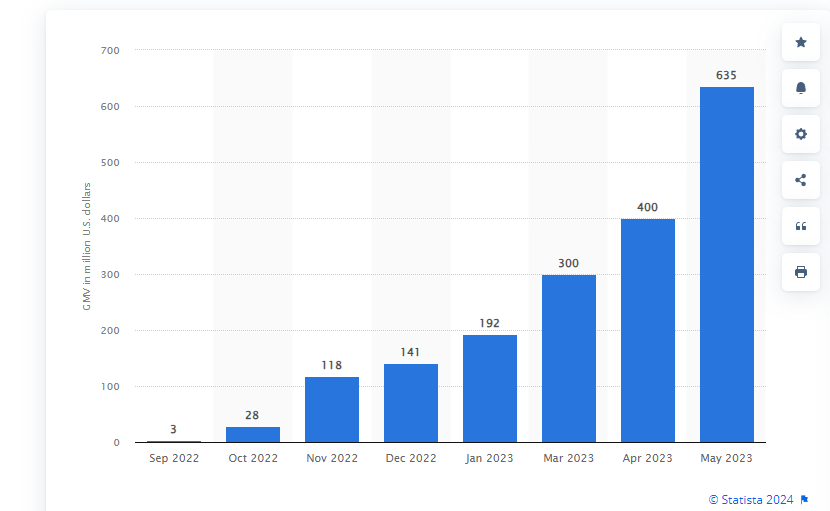
Temu downloads by country May 2023 (%)
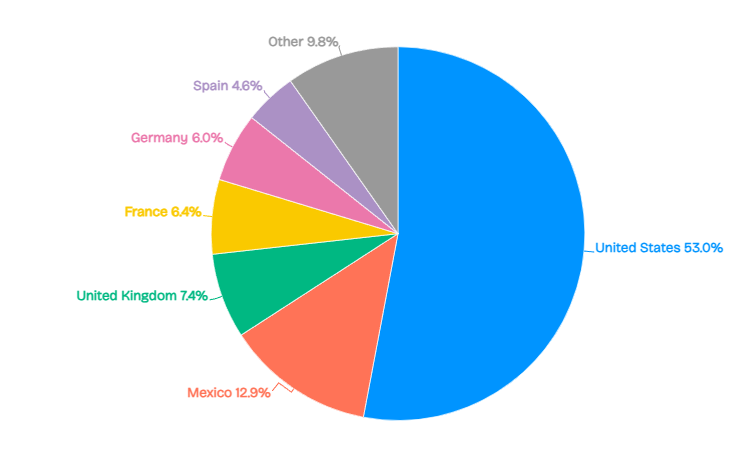
The fundamental elements of the Temu marketing strategy
A company does not grow as quickly as Temu without a clever marketing strategy. Consider these statistics that make Temu an interesting case study:
- Temu’s revenue grew from $3 million in September 2022 to $635 million in May 2023 (Statista).
- Temu’s customer count grew from 5.8 million users in October 2022 to more than 100 million in April 2023 (Bloomberg).
Temu’s business strategy offers a case study on how to successfully market an eCommerce shop for success. These elements of Temu’s marketing strategy can inspire other retailers in the eCommerce space.
Target market
Temu was able to grow its business with a successful targeting strategy. Temu’s customer base consists of young, price-conscious shoppers. As of 2023, people between the ages of 25 and 34 made up the bulk of Temu’s website visitors, followed closely by 35- to 44-year-olds. The audience is split evenly between males and females, with males accounting for 51.54% of the site’s traffic. Temu appeals to a target audience that enjoys video games, news, and online shopping.
Temu’s marketing strategy involves targeted ads in places where its users will see them to appeal to its audience. The company partners with influencers, who make videos about their shopping hauls and post them across social media. The brand also runs promoted social media posts on TikTok, Instagram, and other popular platforms. Its hashtag on TikTok has more than 300 million views, making it a popular location for connecting with potential customers.
Product strategy
Temu’s product strategy is simple — offer affordable products from Chinese manufacturers and wholesalers directly to consumers at the wholesale price. Temu’s products aren’t limited to a specific category. For example, the company doesn’t specialize in clothing, books, or housewares.
Like Amazon, Walmart, and other prime competitors, Temu shoppers can buy anything from clothing to small kitchen appliances. The company offers categories similar to other online retailers and brick-and-mortar department stores, appealing to shoppers who want a one-stop site for whatever they need.
Pricing strategy
Much of the Temu marketing strategy revolves around low prices. The company’s slogan, “Shop like a billionaire,” implies that customers can stretch their money further because they get steep discounts.
Shoppers can find numerous items for less than $10, although the website does require a minimum order size of $15 to check out. According to Temu, this minimum makes it less costly to fulfill orders and discourages people from ordering merchandise to test it out and then returning it. The minimum order is also aiming to increase each customer’s lifetime value.
The company also uses a group buying model, which is popular in Asian countries. This model is a process in which an item is offered at a specific price, assuming enough people will buy it.
Distribution strategy
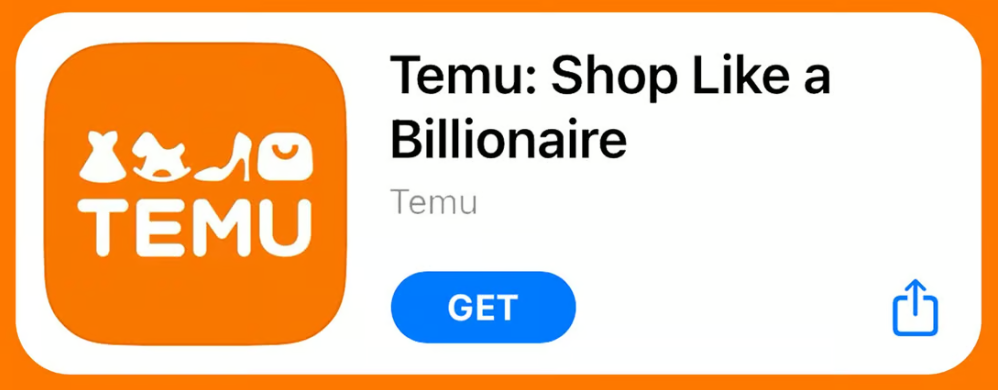
Temu works with many carriers, including the U.S. Postal Service, UPS, and FedEx. Distribution depends on the item. Some items are shipped to customers directly from the manufacturer. In these cases, shipping can take as long as 25 days.
However, other items are available at a Temu distribution center, allowing customers to receive them in three to five days. The company’s warehouse is in California, housing frequently purchased items for American shoppers. Customers looking for niche items will likely have to wait longer for their products to ship.
Promotion strategy
The Temu marketing strategy relies heavily on promoted social media posts and other digital ads. The company maintains a heavy presence on TikTok and YouTube, which are popular with its target audience. Since the company offers a wide range of products, it can target customers based on their interests and search engine history. For example, if someone searches the internet for a black cocktail dress, Temu frequently pops up in their Instagram feed, showcasing a black cocktail dress.
Analyzing Temu’s growth strategy
Temu has managed to grow successfully throughout the past year and has plans to surpass $30 billion in gross merchandise volume by 2037. Here are some strategies that Temu can turn to to achieve its goal.
Private-label strategy
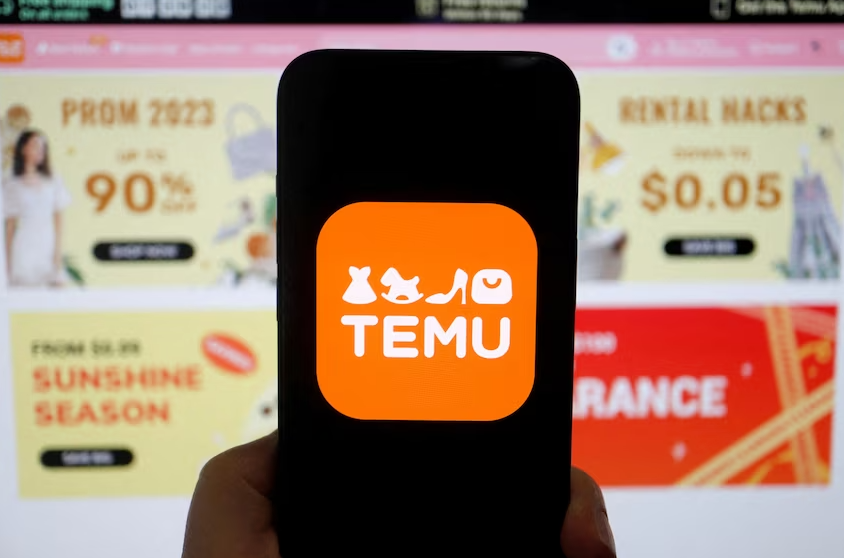
Temu is already capturing customers with its white-label strategy, through which customers can buy products similar to those of other brands without paying for the name. As part of Temu’s strategic planning efforts, the company could consider an approach through which Temu sells products under its own private label. Many retailers already use this strategy, including Walmart, whose private-label grocery brands experienced more than 9% growth in the second quarter of 2023.
Social commerce and digital marketing
The Temu marketing strategy leans heavily on social commerce and digital marketing, relying on these tools to showcase product offerings and attract customers. However, inundating customers with tons of ads could lead to ad fatigue. Since Temu has successfully used social media for brand recognition, the company could consider scaling back on digital marketing, instead of relying on the other innovative techniques it’s already using, such as gamification, to keep potential customers interested. The Temu media network logo is highly recognizable, meaning the company could strategically post ads that get noticed.
Customer-centric initiatives
Customer centricity is a strategy in which a brand makes business decisions based on its customers’ wants and needs. Temu currently uses this approach to keep tailoring its app. The company effectively leverages customer reviews and survey data to improve its app or broaden its product offerings. Companies that follow a customer-centric approach to strategic planning grow between 4% and 8% faster than those that don’t.
Strong partnerships with brands
Since Temu was founded to introduce Chinese brands to new customers, the company already knows how to create brand partnerships. Strong partnerships help build a more trusting relationship with potential customers. If Temu wants to appeal to a vast range of shoppers, it could consider partnering with famous brands in the U.S. and other countries in which it aims to expand.
Identifying the Temu marketing strategy and its unique selling points
Temu’s global marketing strategy centers around the aspects that offer the most value to customers worldwide. Here is where the company delivers value to its target customers.
Shipping policy

Temu offers free shipping on most orders, and free express shipping for all orders over $129. This differs from many online marketplaces, for which shipping rates are set by sellers. Amazon offers free shipping, but only to Prime members. Our Temu case study showcases how giving this perk to people without making them buy a membership can boost a brand, particularly when entering the crowded eCommerce market.
Product variety
By offering a wide variety of merchandise, Temu appeals to all kinds of shoppers. The company uses personalized targeting to filter out irrelevant merchandise based on a customer’s browsing and purchasing history. It also allows customers to save specific items or look through trending items to find their next purchase.
The Temu app
Temu has quickly become one of the most popular apps of 2023. Customers who log in to the app can spin the wheel of fortune to get discount coupons, and the chance to win a big prize. Everyone wins, meaning users always receive a discount on their purchases. Unlike other shopping apps, Temu offers gaming-like features, including banner ads with quizzes that direct users to new merchandise. Temu’s app is fun and user-friendly.
Private brands and diverse merchandise
Since Temu is a marketplace, it offers a variety of brands. Customers can look for exclusive brands with great deals. All they have to do is search for a brand with filters or sort merchandise with the highest ratings. The app currently offers more than 100 product categories supplied by a global network of sellers.

Analyzing Temu’s eCommerce website
A Temu case study would not be complete without a review of the online shopping experience. As an exclusively online brand, it’s important for Temu to have a user-friendly website.
Analyzing Temu’s homepage

Part of Temu’s marketing strategy revolves around adding challenges and other game-like features to the site, making the homepage more engaging.
What we liked:
- There’s a rotating bar of “lightning” deals based on what the customer cares about.
- Prominent banners with information like free shipping, returns and price adjustments.
- The site is easy to navigate.
- There’s a clear explanation of policies at the top of the page.
What we didn’t:
- The site does seem cluttered at first.
- The volume of products is a little overwhelming.
- Categories are confusing (e.g., clicking on “sports” brings up clothing).
Analyzing Temu’s category page

As part of Temu’s marketing strategy, customers see recommended categories based on their preferences. However, it’s easy to find other types of merchandise as well.
What we liked:
- The categories are well organized.
- It’s easy to filter the results to find a specific product.
- The featured category sidebar is easy to navigate.
- Clear star-rated product reviews under each item.
What we didn’t:
- There are a lot of categories, which can make it hard to decide which to choose.
- Subcategories aren’t always relevant.
- Temu could use better landing page photos.
Analyzing Temu’s product page

What we liked:
- The sticky cart makes it easy to check out.
- Product pages offer videos to show how the products work.
- Reviews are prominently displayed.
What we didn’t:
- There’s a pop-up showing how many other people had the item in their carts.
- Multiple messages pop up at the bottom of the screen.
Analyzing Temu’s checkout process

What we liked:
- The app walks shoppers through the checkout process.
- The checkout page is easy to navigate.
- Discount codes are easy to apply.
What we didn’t:
- Logging in through Facebook did not autofill shipping information.
- There’s no guest checkout option.
- The user has to navigate through multiple screens to complete the checkout process.
The most significant challenges Temu has encountered
As of 2023, the Temu marketing strategy appears to be paying off. Its sales and user base continue to rise after just a single year of operation. Temu’s case study is unique in that the company is new and has grown quickly by tapping into 21st-century marketing strategies. However, the company does face its share of challenges.
Logistical challenges
Since most of Temu’s suppliers are based in China, the company can’t offer shipping as quickly as companies that are based in the U.S.
How Temu has tackled the challenge: Temu opened a distribution warehouse in California. Since this warehouse is stocked with American shoppers’ favorite items, it’s easier to fulfill most orders.
Technological challenges
Another app from Temu’s parent company was pulled from the Google app store because of malware. Temu customers may have concerns about their data privacy and the company’s ability to protect their information.
How Temu has tackled the challenge: Temu does not ask for as much data as its sister app, it doesn’t request as many permissions from a user’s phone, and it doesn’t store the same amount of data. However, the company has not completely resolved this issue yet.
Financial challenges
Distribution is a big hurdle for Temu. The company is losing millions of dollars on shipping and other costs in an effort to compete with well-known eCommerce brands.
How Temu has tackled the challenge: PDD has experience with sacrificing profitability to increase its market share. However, it remains to be seen whether this approach will be sustainable for the Temu marketing strategy over the long term.
Interesting technology utilized by Temu
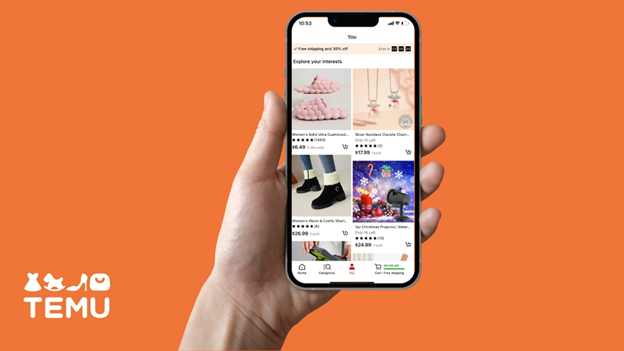
Using the BuiltWith tool, we scanned Temu’s website and highlighted the most impressive technologies spotted:
- CrUX data set: This tool allows a business to see how its users interact with the site. With this data, Temu can customize the user experience.
- Cloudflare: Cloudflare helps optimize webpages for faster loading and better performance. Temu can use it to make sure the site is functioning even with multiple users.
How ContactPigeon could shape the Temu marketing strategy
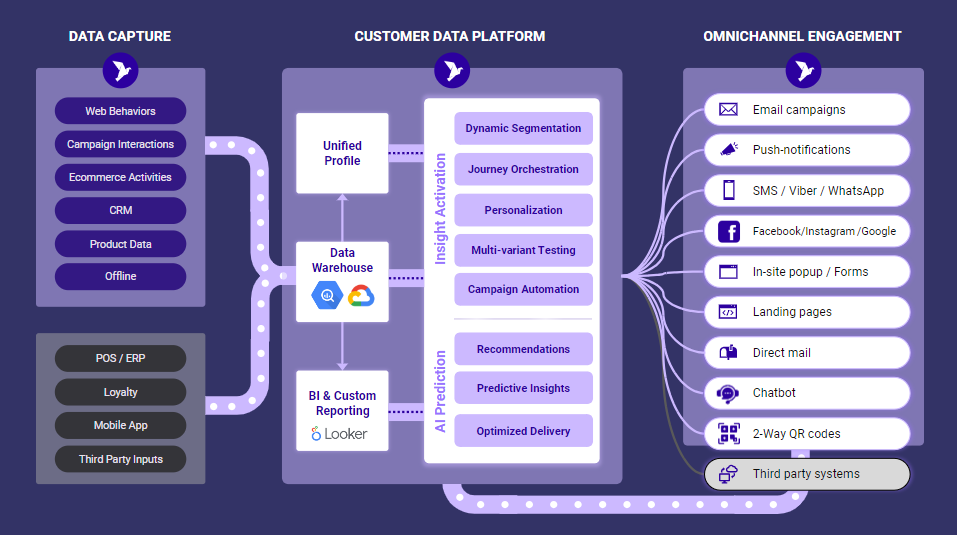
Incorporating ContactPigeon’s Customer Data Platform into Temu’s marketing strategy can revolutionize how the brand engages with its customers. By leveraging unified customer profiles, advanced segmentation, omnichannel marketing automation, behavioral triggers, and robust analytics, Temu can deliver personalized and impactful marketing campaigns.
- Unified customer profiles: By leveraging 360-degree customer insights, Temu can deliver highly personalized experiences, tailor product recommendations, and optimize marketing messages based on individual customer journeys.
- Advanced segmentation: ContactPigeon’s CDP could aid Temu segment its customer base with precision using advanced filtering and segmentation capabilities. Whether it’s based on demographics, purchase history, browsing behavior, or engagement level, Temu can create hyper-targeted campaigns.
- Omnichannel marketing automation: One of ContactPigeon’s strengths is its ability to orchestrate campaigns across multiple channels—email, SMS, web push, and more. With omnichannel personalized offers, Temu can maintain consistent and seamless communication across all customer touchpoints.
- Behavioral triggers and personalization: Temu can set up behavioral triggers such as cart abandonment reminders, product replenishment notifications, or post-purchase follow-ups. By addressing customers at key moments with relevant messages, Temu can significantly boost engagement and drive sales.
- Analytics and insights: Temu can track key metrics, identify trends, and measure ROI with precision, using actionable insights into campaign performance and customer behavior. This data-driven approach will allow Temu to continually refine and optimize its marketing strategies, ensuring that efforts are aligned with business objectives and market demands.
- Integration capabilities: ContactPigeon’s seamless integration with other tools and platforms used by Temu (such as eCommerce platforms, CRM systems, and social media channels) ensures that data flows smoothly and systems work in harmony. This integrated ecosystem enhances operational efficiency and ensures a cohesive customer experience.
Key lessons learned from Temu’s marketing strategy for retail executives
Temu’s marketing strategy showcases several innovative and effective tactics that have contributed to its success in the eCommerce space. Here are the key lessons retail executives can take away:
- Targeted Advertising:
- Utilized social media ads and influencer partnerships effectively to reach young, price-conscious shoppers.
- Leveraged personalized ads based on user behavior and interests to increase engagement and conversions.
- Omnichannel Marketing:
- Employed a comprehensive omnichannel strategy including digital and television advertising, enhancing brand visibility across multiple platforms.
- Gamification:
- Incorporated gamified elements like discount wheels and interactive quizzes in their app to create a fun and engaging shopping experience.
- Competitive Pricing:
- Focused on offering steep discounts and a group buying model to attract cost-conscious consumers, making the shopping experience feel like a bargain hunt.
- Efficient Distribution:
- Improved logistics with a U.S.-based distribution center to expedite shipping times, balancing cost and efficiency.
- Customer-Centric Approach:
- Used customer feedback and reviews to continuously improve the app and product offerings, ensuring alignment with customer needs and preferences.
- Diverse Product Range:
- Offered a wide variety of products, catering to diverse consumer needs and increasing the likelihood of repeat purchases.
Notable Temu stats
The famous brand has surely boosted its brand visibility and parlayed notoriety into success. Take a look at the stats below for a complete overview of the Temu marketing strategy and its success.
- Temu generated $635 million in gross merchandise volume in May 2023 (Statista).
- Temu has become the fourth-most popular eCommerce marketplace (MobiLoud).
- 130 million people downloaded Temu in July 2026 (MobiLoud).
- Temu spent an estimated $1.4 billion on advertising in 2023 (Wired).
- Temu ranked 85th in global website visits in October 2023 (Similarweb).
- The average user visited 6.68 pages on the site in October 2023 (Similarweb).
Temu’s most recent news
The Temu marketing strategy has been in the news a lot as of late, but not all of it has been positive:
- Temu is experiencing an uptick in complaints from customers who say they’ve been incentivized to purchase (WHIO).
- Shein and Temu were involved in court cases regarding intellectual property and other concerns, but both companies have agreed to end the cases (Reuters).
Discover more reports about Temu
- Temu brand awareness rises, as poll shows 9 in 10 Americans know the online marketplace (Digital Commerce 360)
- Temu Statistics – An Analysis of Their Reach, Performance & Controversies (Tech Report)
Resources about other renowned fashion retailers
- How ZARA Dominates the Ecommerce Fashion Industry
- Why ASOS is the Absolute UK Ecommerce Success Story
- New Look: The Marketing Strategy Behind the UK Fast-Fashion Retailer
- Farfetch Case Study: Analyzing The Strategy of the UK Fashion Unicorn
- The Marks and Spencer eCommerce Case Study: 3 Growth Lessons for Retailers
- SUPERDRY Case Study: The Marketing Strategy Behind One of the Top UK Clothing Retailers
- Macy’s Marketing Strategy: How the Omnichannel Clothing Retailer Scaled
Utilize the Temu case study as a driving force for growth
In retail, customer engagement is a must and Temu’s customer base consists of a high portion of tech-savvy youth, that the company learned how to engage effectively. Retailers can pick up some tricks from the company’s success by tapping into their target customers and creating an omnichannel engagement strategy that highlights their value for each customer. Temu knew that it could deliver value at the low prices customers wanted and used intense social media advertising to deliver this message.
But before you execute your engagement strategy, learn about your customers and how to appeal to them. Book a free retail engagement consultation with ContactPigeon, which was recently named the easiest-to-use automation platform worldwide, according to G2. We’ll help you find the right engagement touchpoints for your audience and teach you how to automate customer interactions to boost your website visits and sales.

Let’s Help You Scale Up


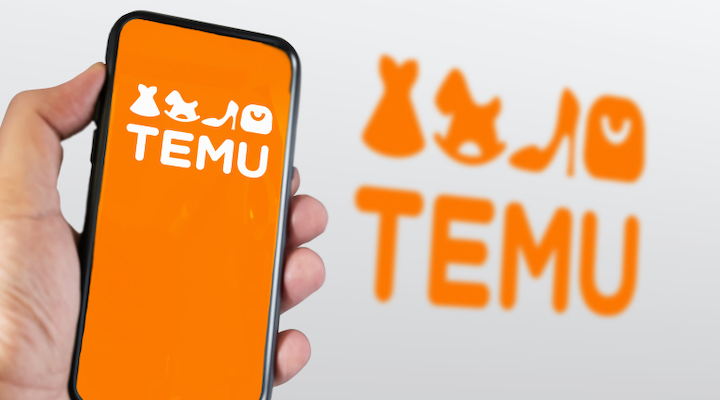

![Benchmarking Growth Strategies of Top Fashion Retailers [Study]](https://blog.contactpigeon.com/wp-content/uploads/2025/11/top-fashion-retailers.jpg)